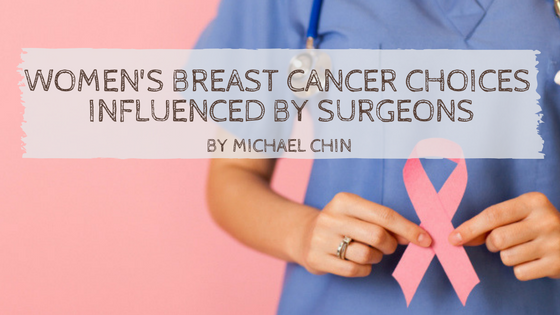In the United States, about 1 in 8 women will develop invasive breast cancer in her lifetime. That means that if you’re a woman living in the U.S., there is a 12% chance you’ll contract this devastating disease. As startling as this statistic is, it’s the truth. While the advances in breast cancer research are encouraging, the scary truth of the matter as it currently stands is that about 40,450 women are expected to die from breast cancer in the United States in the year 2016, and although a woman who has a first-degree relative who has been diagnosed with breast cancer is at much greater risk than a woman without a family history of breast cancer, the greatest risk factors for the disease are gender (being a woman) and age (getting older). About 85% of breast cancers are caused by random genetic mutations and family history is not a factor.
These statistics, as bleak as they are, are also encouraging women, even women with cancer in only one breast and without a great genetic risk of developing it in the second, to get double mastectomies. When a woman has surgery to get both the cancerous breast and the healthy, non-cancerous breast removed as a preventive measure, the procedure is called a contralateral prophylactic mastectomy (CPM). CPMs have been on the rise in the United States in recent years, increasing from 1.8 percent in 1998 to 4.5 percent in 2003 and tripling between 2002 and 2012. Additionally, among women choosing to have a mastectomy instead of a lumpectomy, the rate of CPM nearly tripled, going from 4.2 to 11 percent.
In most cases, women choosing to take matters into their own hands and take charge of their health is a great thing. Medicine and research only go so far in boosting morale, so that positive attitude of saying no to cancer is just what we need to stand against the disease. However, according to the Susan G. Komen organization, the health benefits of CPMs are unclear.
Time magazine reports that, “The overall survival among women opting for CPM is no different from that of women choosing lumpectomy, in which only a portion of the affected breast is removed.” Therefore, the unprecedented rise in CPMs is cause for concern among the medical community.
According to a new study from the University of Michigan, a breast cancer patient’s surgeon has the most influence in determining her treatment options. This study was inspired by the increase in women getting double mastectomies. “We wanted to understand why it was that women were using this procedure, even though it is not likely to yield any medical benefits,” said Reshma Jagsi, professor of radiation oncology at the University of Michigan and lead author of the study.
The study revealed that of the 1,569 women surveyed in Los Angeles and Georgia with cancer in one breast and not the other, only 1.9 percent opted to have a double mastectomy if their surgeon recommended against it. Conversely, in the same group of women, 19 percent decided to get a double mastectomy if they got no recommendation at all from their surgeon. Based on these findings, it would seem that a surgeon’s recommendation has a lot of sway in influencing a woman’s decision whether or not to have a double mastectomy. The study also found that the majority of women getting double mastectomy surgery are white, younger, better educated, and wealthier than women who do not have the surgery. The women having the surgery cited “peace of mind” as their reason for going through with it.
The hope behind this study is that it will lead to better patient-physician communication. The challenge for surgeons and physicians, according to breast surgeon Tom Julian of the Allegheny Health Network, will be to communicate to patients that, despite the fear they experience at being diagnosed with breast cancer, it does not make sense (in most cases) to get a double mastectomy.

